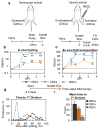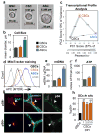mTORC1 controls the adaptive transition of quiescent stem cells from G0 to G(Alert)
- PMID: 24870234
- PMCID: PMC4065227
- DOI: 10.1038/nature13255
mTORC1 controls the adaptive transition of quiescent stem cells from G0 to G(Alert)
Abstract
A unique property of many adult stem cells is their ability to exist in a non-cycling, quiescent state. Although quiescence serves an essential role in preserving stem cell function until the stem cell is needed in tissue homeostasis or repair, defects in quiescence can lead to an impairment in tissue function. The extent to which stem cells can regulate quiescence is unknown. Here we show that the stem cell quiescent state is composed of two distinct functional phases, G0 and an 'alert' phase we term G(Alert). Stem cells actively and reversibly transition between these phases in response to injury-induced systemic signals. Using genetic mouse models specific to muscle stem cells (or satellite cells), we show that mTORC1 activity is necessary and sufficient for the transition of satellite cells from G0 into G(Alert) and that signalling through the HGF receptor cMet is also necessary. We also identify G0-to-G(Alert) transitions in several populations of quiescent stem cells. Quiescent stem cells that transition into G(Alert) possess enhanced tissue regenerative function. We propose that the transition of quiescent stem cells into G(Alert) functions as an 'alerting' mechanism, an adaptive response that positions stem cells to respond rapidly under conditions of injury and stress, priming them for cell cycle entry.
Figures




Comment in
-
Stem cells: keeping alert.Nat Rev Mol Cell Biol. 2014 Jul;15(7):428-9. doi: 10.1038/nrm3834. Nat Rev Mol Cell Biol. 2014. PMID: 24954201 No abstract available.
-
Stem cells on alert: priming quiescent stem cells after remote injury.Cell Stem Cell. 2014 Jul 3;15(1):7-8. doi: 10.1016/j.stem.2014.06.012. Cell Stem Cell. 2014. PMID: 24996163
References
-
- Wilson A, et al. Hematopoietic stem cells reversibly switch from dormancy to self-renewal during homeostasis and repair. Cell. 2008;135:1118–1129. - PubMed
Publication types
MeSH terms
Substances
Associated data
- Actions
- Actions
Grants and funding
LinkOut - more resources
Full Text Sources
Other Literature Sources
Molecular Biology Databases

